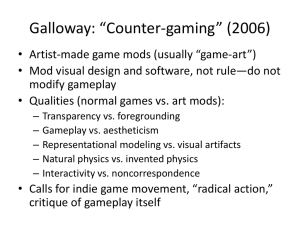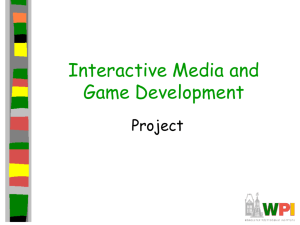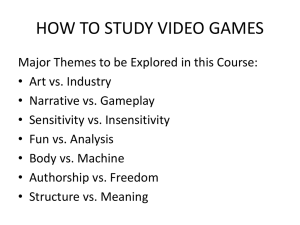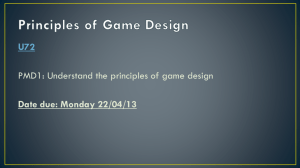Easy to use and incredibly difficult: on the mythical Please share
advertisement
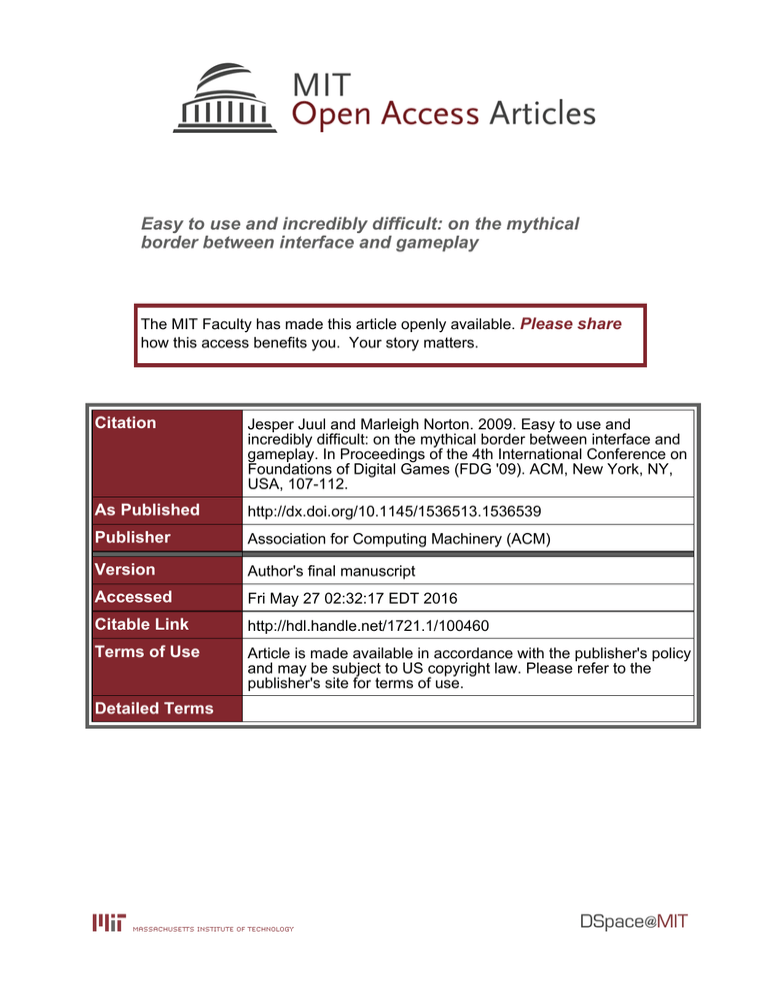
Easy to use and incredibly difficult: on the mythical border between interface and gameplay The MIT Faculty has made this article openly available. Please share how this access benefits you. Your story matters. Citation Jesper Juul and Marleigh Norton. 2009. Easy to use and incredibly difficult: on the mythical border between interface and gameplay. In Proceedings of the 4th International Conference on Foundations of Digital Games (FDG '09). ACM, New York, NY, USA, 107-112. As Published http://dx.doi.org/10.1145/1536513.1536539 Publisher Association for Computing Machinery (ACM) Version Author's final manuscript Accessed Fri May 27 02:32:17 EDT 2016 Citable Link http://hdl.handle.net/1721.1/100460 Terms of Use Article is made available in accordance with the publisher's policy and may be subject to US copyright law. Please refer to the publisher's site for terms of use. Detailed Terms Easy to Use and Incredibly Difficult: On the Mythical Border between Interface and Gameplay Jesper Juul Marleigh Norton Singapore-MIT GAMBIT Game Lab Singapore-MIT GAMBIT Game Lab 5 Cambridge Center 5 Cambridge Center Cambridge, MA 02142 Cambridge, MA 02142 +1 617 324-8973 +1 617 324-8932 j@jesperjuul.net marleigh@mit.edu ABSTRACT In video game literature and video game reviews, video games are often divided into two distinct parts: interface and gameplay. Good video games, it is assumed, have easy to use interfaces, but they also provide difficult gameplay challenges to the player. But must a good game follow this pattern, and what is the difference between interface and gameplay? When does the easy-to-use interface stop, and when does the challenging gameplay begin? By analyzing a number of games, the paper argues that it is rare to find a clear-cut border between interface and gameplay and that the fluidity of this border characterizes games in general. While this border is unclear, we also analyze a number of games where the challenge is unambiguously located in the interface, thereby demonstrating that "easy interface and challenging gameplay" is neither universal nor a requirement for game quality. Finally, the paper argues, the lack of a clear distinction between easy interface and challenging gameplay is due to the fact that games are fundamentally designed not to accomplish something through an activity, but to provide an activity that is pleasurable in itself. Keywords Usability, challenge, game design, game studies, gameplay, interfaces. 1. Introduction Video games are easy, and video games are difficult. Video games can be notoriously challenging, but even challenging games often have easy-to-use interfaces. Now, what is the difference between ease of use and challenge? Where does the easy interface end, and where does the difficult gameplay begin? To explore this question, let us first consider what we mean by interface and what we mean by gameplay. ‘Interface’ is the easier definition. For the purposes of this paper, the interface is considered to be the software and hardware tools that the player uses to understand and affect game state. The interface can ICFDG 2009, April 26–30, 2009, Orlando, FL, USA. Copyright 2009 ACM 978-1-60558-437-9…$5.00. include controller buttons, mouse clicks, menus, status bars, and field of view. ‘Gameplay’ is a more nebulous term that is specific to a given video game. This will be expanded later, but for now, the gameplay is considered to be core activity of the game which is accessed through the interface. Many recent texts on game development describe how usability methods can be used to improve video games[1][2], but the relationship of inspiration between usability methods and game design has historically gone both ways. Video games have occasionally been singled out as gold standards of interface design. Hypertext guru Theodor Nelson describes it like this: To see tomorrow's computer systems, go to the video game parlors! ... Look there to see true responsiveness, true interaction. Compare these with the dreary, pedestrian office software we see everywhere, the heavy manuals and Help Screens and Telephone Support.[3] Elsewhere, Ben Shneiderman similarly claims that 1980's arcade games were successful examples of good interface design principles, but mentions in passing that games are also different from "normal" applications because games are meant to challenge users where applications are not: However, game players seek entertainment and the challenge of mastery, while application-system users focus on the task and may resent forced learning of system constraints. The random events that occur in most games are meant to challenge the user, but predictable system behavior is preferable in nongame designs. Game players compete with the system, but application system users apparently prefer a strong internal locus of control, which gives them the sense of being in charge.[4] Similarly, a paper from Microsoft Game Studios describes how the usability issues of games are similar to those of productivity software, while pointing to how games are also different: Games share some important similarities with productivity applications, similarities that make the process of improving the user experience with games similar in some ways to the one used with applications. ... Users of productivity applications must be satisfied with the experience, but the primary concern is that they are able do what they need to do (accomplish tasks) easily, quickly and effectively. In contrast, games must be “fun.” Games must also be challenging, but challenge is something that applications are typically designed to minimize.[2] In these descriptions, good games are similar to good productivity software in that they should make tasks easy, but good games are also different from productivity software because games make tasks difficult! Having established this, we face the problem of telling the difference: what should be the easy parts, and what should be the difficult parts of a game? Though Shneiderman and Nelson praise video games as models of interface design, playing a modern video game is rarely an experience of interface bliss. A more common experience of contemporary video games may rather be that of facing an overly complex interface that subjectively "gets in the way" of what the player wants to achieve in the game. Since difficult-to-use interfaces are thus easily associated with flawed games, it is tempting to assume that video game quality consequently hinges on easy-to-use interfaces. This leads to the distinction that the interface should be as easy as possible to use, while the gameplay should be challenging. In game design literature, Richard Rouse III describes how it is important to create games with the right amount of challenge, while emphasizing that using the interface ("input/output systems") should be effortless: or explicit assumption is that the interface should be easy and the gameplay should be challenging. This is a tempting assumption, as it does seem to bear out in many simple cases. Consider the example of a computer-based chess game: Such a game would be badly designed if the interface made it difficult to move the chess pieces. On the other hand, we would expect it to be difficult to decide where to move each piece in order to eventually win the game. This is a clear distinction between the easy interface and the difficult gameplay. We can use usability literature to describe this in further detail: Michel Beaudouin-Lafon distinguishes between the interaction instruments at the disposal of a user, and the domain objects that the user can use the interaction instruments to operate upon.[8] In chess, the interaction instruments should make it easy for the user to move the chess pieces—drag and drop would be an appropriate instrument, by which the player uses the mouse to move the chess pieces directly—but the chess pieces are domain objects that can be organized in a way that requires the mastery of difficult strategies. Hence we reach a useful distinction between easy interface and difficult gameplay: easy to perform the concrete act of moving the chess pieces according to the rules of the game; difficult to move them strategically well. Your game’s input and output systems are two of the primary factors that determine how steep the learning curve for your game is and whether players will find it intuitive to play. Using the input/output systems you design, players must be able to control and understand the game effortlessly.[5] The same assumption can be found in video game journalism, where a preview of the game Killzone 2[6] initially describes how the interface is more challenging than the reviewer would like: I thought the controls themselves took a while to get used to, particularly remembering which two shoulder buttons were used for hugging the wall and throwing a grenade... I also thought the aiming wasn’t as precise as I would have liked.[7] The reviewer then proceeds to describe how the main gameplay is satisfying because it is challenging: The combat itself was, overall, really satisfying. There were situations where I felt I was safe, but got flanked by a group of on-coming Helghast from the side. You have to really pay attention at times.[7] This argument builds implicitly on the distinction outlined above; pressing a button to launch a grenade is an interface feature, so it should be easy. Deciding when and how to launch a grenade is part of the core gameplay of combat, so it should be challenging. Difficulty in accomplishing a task is only considered acceptable if the task is part of core gameplay (e.g. winning a fight) but not if it is part of the interface (e.g. remembering which button does what). 2. Interface vs. Gameplay As we saw above, the interface is frequently considered a way to interact with the game, but not part of the gameplay. The implicit Figure 1: Street Fighter II (Capcom 1991) If we apply this perspective to an original video game, Street Fighter II[9] shown in Figure 1, the distinction is at first straightforward: the controls of the arcade cabinet let players move their characters and press buttons to perform various fighting moves. The easy interface lets the player control the character, but the difficulty lies in making the right moves. This even matches the adage from game design literature that quality video games are easy to learn, but difficult to master.[10][11] This appears to be a perfect match: the interface should be easy to learn, but the gameplay should be difficult to master. While the distinction between easy interface and challenging gameplay holds up on a cursory examination, even simple games have features that are not easily mapped to this model: In Street Fighter II, many of the advanced actions in the game are not at all straightforward: players can use special attack moves for the characters they control, but these moves must be activated through convoluted button combinations that players must generally discover for themselves1. In this way, the game 1 A guide to Street Fighter II: World Warrior gives the following advice for how to perform a fireball move with the Ken/Ryu characters: Fireball - Start with control pad and down and roll it diagonally towards your opponent and then end with pressing the direction your opponent is and any Punch at contains a clear design choice of making some actions easily accessible (pull the stick left to move left), but making other actions difficult to access (combine button pushes to perform special moves). If we look at chess again, we can point to features which do not easily fall into the categories of either interface or gameplay. Each piece, for example, has its own complex set of possible moves. Traditionally, the player must memorize these rules of movement in order to play. Is this memorization part of the gameplay or simply an interface limitation of using a traditional, physical chess set? In computer-based chess, an interaction instrument could be provided such that when a piece is selected, all possible valid moves light up. If movement rules are considered part of the interface, the answer would be to implement such a feature on the theory that it makes the interface easier to use. If it is considered part of the gameplay, similar to how advanced moves must be discovered and memorized in Street Fighter II, the feature should be omitted since memorization is a gameplay challenge2. If remembering the movement patterns in chess seems too simple to merit characterization as a challenge, consider the more specialized moves such as castling or en passant. Many players are not aware of these rules; knowing them gives advantage to expert players. By building this knowledge into the interface, a chess game would reduce the challenge of knowing all the game rules, and thereby alter the game experience. Figure 3: Toribash (H. Söderström 2006) To further blur the line between easy interface and challenging gameplay, compare Street Fighter II to Rag Doll Kung Fu[12] shown in Figure 2 and Toribash[13] shown in Figure 3. All three have the same game premise—the player controls a martial artist in one on one combat—but between these three games, the interaction instruments are progressively more cumbersome and require progressively more fine-grained control3. Rag Doll Kung Fu and Toribash openly break fighting game conventions by making the player manipulate the individual limbs of the character rather than moving the entire character at once. The two games are also quite different: Rag Doll Kung Fu is a real-time game where the player pulls the individual limbs using the mouse, but Toribash is a turn-based game where the player lines up a sequence of movements for individual joints. Of the two games, Toribash probably has a steeper learning curve that makes even the act of walking extremely complicated. Since it has the most complex interaction instrument, the common interface/gameplay division might lead us to conclude that Toribash would be universally perceived as the lowest-quality game of the three. Indeed, there are those who would agree. Here is a generally negative review, emphasizing the slowness and general difficulty of the interface: The gameplay is click this click that...and I get really impatient before the round is over. The commitment involved to alter each muscle is too much. I really wanted to be able to click a body part and drag and rotate it where I wanted to. It's an acquired taste, but managing each muscle every move isn't really for everyone.[14] Figure 2: Rag Doll Kung Fu (Qi Studios 2005) the same time you press left or right. The more powerful the Punch you use, the faster the fireball.[25] 2 On the other hand, a more positive review emphasizes both how the game allows a different "thinking" approach to fighting games, and how the interface is easy to use: The interface makes it very easy to see what each joint you select is set to do and the ghosting on your figure allows you to accurately see the result of your path of action. It's point and click. So, while gameplay can be very slow, it lends itself very well to what Toribash is trying to be: the thinking gamer's fighting game.[15] In an April Fool’s joke, game site GameSpot reviewed chess as if it were a newly-released game that should be measured by the standards of contemporary video games. The review concludes that the required memorization of the game rules is a major flaw: This game attempts to accredit itself by virtue of its tactical play mechanics. Yet those mechanics are tedious and difficult to grasp and exacerbate Chess's other numerous failings. In fact, should you actually memorize all the infuriating little rules governing how the game is played, you'll find yourself growing weary of it all in short order.[26] 3 An alternative interpretation would be that in fighting games, the primary domain object is the opponent, whom the player wishes to reduce to zero health. To do so, the player is provided with an interaction instrument in the form of a martial artist character. These reviews show two different interpretations of Toribash: • Interpretation #1: Toribash is a bad fighting game with a difficult interface for controlling the entire character. • Interpretation #2: Toribash is a good game with an easy interface for controlling the joints of a character. As we can see, the success of this game hinges on player expectations. If players sit down expecting to play a game like Street Fighter II, they will find Toribash very disconcerting. Success will depend on whether or not players overcome their expectations enough to enjoy the game which is actually there, despite its unconventional interface. Reviewers such as the ones quoted are generally fluent in a variety of video game genres, meaning that they may perceive a common interface as "easy" when it is really an interface with which the reviewer has had more practice. A player unfamiliar with the fighting game genre may find the interfaces of Street Fighter II, Rag Doll Kung Fu, and Toribash equally difficult. More reflective players may even find Toribash to have the easiest interface, since it allows the most time for strategizing. 3. What is the Game? As we explore the difference between ease and difficulty, we return to the example of chess. The distinction between interface and gameplay is clear in chess because we already know what that game is. As players, we already have an expectation about what should be the difficult part of the game, and what should be the easy part. We expect that the strategy of deciding where to move the chess pieces is difficult, but we expect the concrete act of moving the pieces to be easy. But if we had no prior experience with chess, it would not be obvious what should be the easy and difficult parts of the game. Perhaps we could imagine a game called "chess" where the interaction instruments were deliberately made obtuse. Could there be an alternative version of chess where the basic strategy was simple, but where it was difficult to move the individual pieces, similarly to how Toribash redefines the fighting game by emphasizing the strategic control of joints rather than the adrenaline rush of movement emphasized by Street Fighter II? Figure 5: Boom Blox (Electronic Arts 2008) The Jenga[16]-inspired video game Boom Blox[17] shown in Figure 5 is another such case, where it is hard to uphold a distinction between interface and gameplay. While we probably expect Boom Blox—building on Jenga conventions—to make it difficult to move individual blocks the right way, we can also imagine a version of Boom Blox where access to the game objects was too difficult in some way—perhaps if the interaction instruments made it difficult to select the block you wanted to move. This shows that we cannot equate video game quality with easy-to-use interfaces, as the challenge of a game may very well be located in the interface. On the other hand, even such a game may still have a badly-designed interface that is too hard to use. For example, one of the authors has witnessed how Boom Blox players frequently pause the game by mistake because the "home" button of the Wii controller is placed close to the gameplayrelevant buttons. Where the difficulty of moving the individual blocks the right way is experienced as integral to the game, the difficulty of not pressing the home button is experienced as design flaw. Even when the game challenge is located in the interface, the interface may still be unduly challenging. Figure 6: WarioWare: Smooth Move (Intelligent Systems 2006) Figure 4: Mikado / pick-up sticks (©2006 Maciej Szczepaniak) Games do exist where the gameplay challenge is located in the interface. Take the game Mikado (or "pick-up sticks") shown in Figure 4, wherein the goal of the game is to remove sticks from the pile without causing other sticks to move. There is only a small element of strategy in the game, and the core challenge—the gameplay—of the game is in the interface, in the difficulty of moving the pieces as such. Many video games, past and present, have had badly designed user interfaces. This yields the possibility of a game deliberately playing with such issues: In the WarioWare series[18] (Figure 6), the individual minigames of the larger game are confusing as to what the player is supposed to do, but the actual execution of a minigame is mostly simple once the interface has been understood. In other words, the gameplay challenge is understanding the interaction instruments, not the domain objects. In WarioWare, this is presented as a parody of bad video game design. While many games have no clear distinction between easy interface and difficult gameplay, the tension between the two is nevertheless a source of game innovation. 4. Inefficient Interfaces Video games are different from productivity software because productivity software, all things considered, is bound by whatever it is meant to achieve. The developer of a word processor is expected to emphasize usability above all things, but game developers are expected to provide obstacles for the sake of entertainment. Game developers have a much larger degree of freedom in choosing both what the game is and where to place the challenges that users face. For example, where the Grand Theft Auto III[19] games demanded that players find their way around town, Grand Theft Auto IV[20] provides an in-car GPS with driving directions to aid with navigation. Where the earlier games had navigation as a challenge, navigating around town in Grand Theft Auto IV is no longer the game. Video game history develops by shifting focus, by redefining what the game is. Music games have also redefined what a video game can be as they are almost completely without strategic choices. In such games, most of the difficulty of the game lies in the interface, like in Jenga or Boom Blox4. There are no inherent limits to what can be made difficult in a game, as having inefficient interaction instruments adds challenge to a game. Game developer Blizzard uses the term skill differentiation[21] to describe how requiring a range of skills allows players to grow: a real-time strategy game can have "twitch" skills, multitasking, strategic thinking, understanding of economy, knowledge of a map, and so on, as differentiators. From this perspective, a difficult-to-use interface simply adds an extra skill differentiator by which players can improve themselves. For example, in the Blizzard game StarCraft[22], the player can only select twelve units at a time, making it inconvenient to execute many strategic plans. Yet this also makes the ability to use the mouse and keyboard quickly more of a skill differentiator, giving players an additional way in which they can distinguish themselves5. The limit to what can be made difficult comes not from what is possible technically or design-wise, but from what players are willing to accept. Furthermore, the distinction between interface and gameplay is often murky and subject to interpretation, meaning that an experimental game must convince players to adjust their expectations of what should be easy and difficult in a game. The lingering question here is in what way, if any, games can be said to have easy-to-use interfaces. Consider the game definition of a classic game studies text, The Grasshopper[23], wherein Bernard Suits argues that to play a game is to bring about a state of affairs using the less efficient means possible: [To play a game is] to engage in activity directed towards bringing about a specific state of affairs, using 4 5 The perception of chess as a game of pure strategy rather than skill is what at first makes it appear to match the easy interface/difficult gameplay distinction. While we have argued that there are problems conceiving of chess in this way, the skill elements of Jenga and Boom Blox make these games more obvious counter-examples to the distinction between gameplay and interface. The upcoming StarCraft 2 is rumored to have no limit on unit selection. only means permitted by rules, where the rules prohibit more efficient in favor of less efficient means, and where such rules are accepted just because they make possible such activity.[23] Suits stresses inefficiency as a core trait of games. For example, the easiest way to complete a golf course is to carry the ball to the individual hole and put it in, but golf prevents the player from moving the ball except by way of a golf club, giving the player less efficient means to solving the problem. Suits claims that design work must be put into making the available tools (means) inefficient.This claim is the exact opposite of the usual approach to productivity software, in which much work is put into making the available tools efficient and easy to use. This discrepancy comes in part from Suits' notion of prelusory goals: Suits argues that all games are based on goals that exist prior to the creation of a game - moving a ball into the hole in golf is such a prelusory goal. While this notion has been criticized[24], it does frame games as having naturally easy goals that by design are made difficult to attain. Conversely, the basic assumption in usability may be that computer systems are naturally difficult, and must then be made easy by design. 5. Conclusion We can in some games distinguish between easy-to-use interface, and the gameplay, which we expect to be difficult, but this is not a universal for games. What makes games stand apart from productivity-focused software applications is that this boundary is often blurry, sometimes inverted, and constantly redefined: games can shift focus, redefine what the game is. Games can make the difficult easy by removing it—such as not requiring players to know how to perform a martial arts move—or making the easy difficult by providing extra complications—such as by making players control individual joints of a character. Games differ from productivity software in that games are free to make easy or difficult the different elements of a game. While much may be learned from usability methods about the design of game interfaces, and while many video games certainly have badlydesigned interfaces, it is crucial to remember that games are both efficient and inefficient, both easy and difficult, and that the easiest interface is not necessarily the most entertaining. This tells us something fundamental about games. There is a reason why we cannot uphold a distinction between easy interface and difficult gameplay. Games are not committed to be about anything or to achieve anything, but can be designed for optimum experience, wherever that experience may be found. It is not only about reaching a destination, but also about enjoying the journey. Compare games to poetry: much poetry takes effort to read, but this is a feature rather than a bug, as it cues readers into shifting their focus from the meaning of the words to the words themselves. Poetry is language not simply about communication, but about the beauty of language. Likewise, a game is an activity not simply about accomplishing something, but about the beauty of the activity itself. 6. Acknowledgements Thanks to our colleagues at the GAMBIT lab for providing feedback and criticism for this paper. 7. References [12] [1] T. Fullerton, C. Swain, and S. Hoffman, Game Design Workshop: Designing, Prototyping, and Playtesting Games, San Francisco, CA: CMP Books, 2004. [13] H. Söderström, Toribash, (Windows), 2006. [2] J.P. Davis, K. Steury, and R. Pagulayan, “A survey method for assessing perceptions of a game: The consumer playtest in game design,” Game Studies: The International Journal of Computer Game Research, vol. 5, 2005; http://www.gamestudies.org/0501/davis_steury_pagulayan/ [3] T.H. Nelson, “The right way to think about software design,” The Art of Human-Computer Interface Design, B. Laurel, ed., Reading, MA: Addison-Wesley, 1990, pp. 235-243. [4] B. Shneiderman, “Direct Manipulation: A Step Beyond Programming Languages,” Computer, vol. 16, 1983, pp. 57-69. [5] R. Rouse III, Game Design Theory and Practice 2nd edition, Plano, Texas: Wordware. [6] Guerrilla Games, Killzone 2, Sony Computer Entertainment Europe (PlayStation 3), 2009. [7] J. Reilly, “Killzone 2 Single-Player Impression,” Kotaku, Dec. 2008; http://kotaku.com/5109990/killzone-2single+player-impression [8] M. Beaudouin-Lafon, “Instrumental interaction: an interaction model for designing post-WIMP user interfaces,” Proceedings of the SIGCHI conference on Human factors in computing systems, The Hague, The Netherlands: ACM, 2000, pp. 446-453; http://portal.acm.org/citation.cfm?id=332473 [9] Capcom, Street Fighter II, Capcom (Arcade), 1991. [10] B. Bates, Game Design, Boston, MA: Thomson Course Technology, 2004. [11] T.W. Malone, “Heuristics for designing enjoyable user interfaces: Lessons from computer games,” Proceedings of the 1982 conference on Human factors in computing systems, Gaithersburg, MD: ACM, 1982, pp. 63-68. Qi Studios, Rag Doll Kung Fu, Valve Corporation (Windows), 2005. [14] Mike, “Toribash Review,” The Indie Game Magazine, Oct. 2008; http://www.indiegamemag.com/2008/10/toribashreview.html [15] M. Scarpelli, “Toribash - Review by Game Tunnel,” Game Tunnel, Mar. 2007; http://www.gametunnel.com/gamespace.php?id=356&tab= 3 [16] L. Scott, Jenga, Milton Bradley (board game), 1987. [17] Electronic Arts Los Angeles, Boom Blox, Electronic Arts (Wii), 2008. [18] Intelligent Systems, WarioWare: Smooth Moves, Nintendo (Wii), 2006. [19] DMA Design, Grand Theft Auto III, Rockstar Games (PlayStation 2), 2001. [20] Rockstar Games North, Grand Theft Auto IV, Rockstar Games (Xbox 360), 2008. [21] R. Pardo, “Blizzard's Approach to Multiplayer Game Design,” Game Developers Conference, San Francisco, CA: 2008. [22] Blizzard Entertainment, StarCraft, Blizzard Entertainment (Windows), 1998. [23] B.H. Suits, The Grasshopper: Games, Life, and Utopia, Toronto, ON: University of Toronto Press, 1978. [24] A.J. Schneider, “Pre-lusory Goals for Games: A Gambit Declined,” Journal of the Philosophy of Sport, vol. 24, 1997, pp. 38-46. [25] RCarlos, “Street Fighter II: The World Warrior (ARC) Ryu/Ken,” GameFAQs, Jan. 1999; http://www.gamefaqs.com/coinop/arcade/file/583626/848 [26] GameSpot, “Chess Review,” GameSpot, http://www.gamespot.com Apr. 1998;

